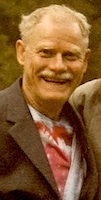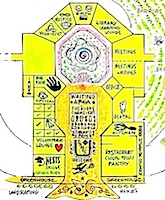




 |
 |
 |
 |
 |
| PAUL
GLOVER ESSAYS: community
control of food, fuel, housing, health care,
planning, education, finance. |
| HOME | INTRO | CURRENCY | SUCCESSES | HOW-TO BOOK | PUBLICITY | ESSAYS |
|
New Health
Alliance
Rebuilds Local Safety Net by Paul Glover HOUR Town, February 1997 We're starting a local non-profit fund to pool our money to reduce our health costs, to support each other, and to make healthy living easier. Costs of health insurance and care have risen by half this decade. Thousands of Ithacans have no medical insurance, and many others are exposed by poor coverage , with high deductibles. A random poll of 125 Ithacans found 36% uninsured, and 98% without dental insurance. Many people find their preferred providers and therapies not covered at all. So we're going to build our own safety net, much as the Amish do. Their communities have created medical "assurance plans." Some Amish gather quarterly to total their community's doctor and hospital bills, where they calculate each family's contributions according to ability to pay (Wall Street Journal 12/22/95, p.1). The U.S. health "industry" is the nation's largest: over $1 trillion ($1 million million) yearly, or 14% of GDP, is fed to a system more organized for profitability than public need. Medical costs have been driven beyond our reach by medical specialization and technology, by the greed of insurance and drug companies, by bureaucratization, and by lawsuits that rise from consumer frustration. Therefore our fund will proceed systematically to make preventive and innovative health care more affordable, and to recapture health insurance premiums for local health purposes. The Health Fund will be governed by a board of directors (representing different health sectors) elected by members at the Health Fund's annual Health Festival. They will adjust the founding interim policies, to maximize member benefits. Funds collected for fees will be held in escrow, returnable upon request until the first 50 providers and 100 members are enrolled. Then the Health Fund will be activated to provide its first compensations. These will take two forms. First, discounts for services and goods: especially those services not yet covered by conventional insurers but which are preferred by area residents. Most services we're proposing to include are on the "menu of services" on the next page. And we'll emphasize preventive care, to reduce our need for acute care and to reduce medical costs. With a properly balanced discount system, benefitting all participants in a mutually satisfying way, we'll create general local price reductions and thus increase discretionary income. Those health providers who give discounts to Health Fund members will themselves receive discounts from an additional list of support businesses. Secondly, payment for acute care: ambulance and emergency room use for broken bones during the first year, then expanding gradually to compensate for services that are most desired and less insured: dentistry, chiropractic, massage therapy, herbal medicine, and so on. We'll be able to do this as we explore the supply and demand for payments. Expanding year by year with the good will of the community, the fund will hold not only membership fees, but tax-deductible donations and bequests, and inflation-indexed loans for health care development. The plan moreover includes flexible payment options-- not merely dollars, but also community service, home visit credits, barter and HOURS. These are more fully described on the next pages, and on the membership form and web site. Every year roughly $50 millions of Tompkins County income are spent for medical services, prescription drugs and medical insurance policies (1990 Census; NYS Dept. of Insurance). That's about $500 per Tompkins County resident. Imagine if this money were dedicated directly to keeping us healthy instead. These millions could establish a series of free clinics, like the 225 free clinics in the U.S. which provide quality health care to low- and medium-income people for a fraction of typical costs. This money could provide complete health cover-age locally, with the Health Fund eventually employing salaried doctors to provide free services. Back in 1929 a farmer's union in Oklahoma started the Elk City Co-operative, which hired doctors to provide medical care on a nonprofit basis to all members. When the AMA tried to block Co-op physi-cians' access to the hospital, the co-op sued successfully (Medical Care and Family Security, p. 229). Based on conversations so far, we expect constructive collaboration with local medical providers. Several local physicians already follow the fine tradition of community doctors who charge what patients are able to pay. We're also compelled to create this fund to protect each other locally because Congress prefers to protect us with weapons more than by healing. Federal military spending takes 52% of the budget (past wars and war debt, plus present spending), while health gets 14%. Were $100 billion/year transferred from the military ($20 billion/year for nuclear weapons, etc.) toward health coverage, all 40 million uninsured Americans would have full health coverage, and all the insured would pay no deductibles (U.S. Government Accounting Office: Canadian Health Care: Lessons for the U.S.; Physicians for a National Health Program). Free Choice in the Health Market. Ithaca's medical doctors and technologies have saved many lives and relieved much pain, yet many area residents feel the need to explore beyond conventional treatments when these have not cured. Even many medical doctors now believe that there's an important role for responsible, credentialed alternatives. Several local physicians are members of the American Holistic Medical Association. Today, former U.S. Surgeon General C. Edward Koop, M.D. is developing an alternative medical center at Dartmouth College. Preventive care and lower-cost innovative therapies will also save us money because low-income patients otherwise wait until symptoms are acute, then resort to expensive pills and surgery at public cost. In New York state, the Foundation for Advancement of Innovative Medicine has successfully lobbied to pass an "Alternative Medical Practices Act" which gives physicians broad powers to prescribe any care that "effectively treats human disease," which includes many complementary therapies. Thus insurance companies are required to cover chiropractic and other treatments having standard protocols (faim.org). The NYS Dept of Insurance has a "special complaint unit" which enforces payment of such claims. NYS Senate Bill 5232 would mandate reimbursement for off-label and experi-mental drugs. Some insurers have opposed such coverage, fearing an overload of claims and cost increases. However, Mutual of Omaha has found they save $6.50 for every dollar spent covering nonstandard 'holistic' |
treatments.
That's because, according to Marc Micozzi, M.D, "effective
use of alternative care can increase member health, reducing
premiums"
Moreover, says Barry Jacobs, M.D., "In the course of complications of
drug therapy, patients who haven't been offered alternatives have
started to sue for negligence" (Vegetarian Times 10/95). Sixteen states now allow insurance companies to cover alternative therapies, ten states license naturopaths, and the state of Washington also requires coverage by insurers of such complementary health care as acupuncture, and massage. Says Merrily Manthey, trustee of a large Seattle hospital who supports naturopathy, "people want to get well in a world where costs and an obsession with high technology are forcing cutbacks in conventional medicine" (NYT 1/2/96). While alternative therapies have already proven to be powerful healers preferred by millions (one third of Americans have used them, according to the New England Journal of Medicine), the medical industry dismisses most as "unstudied and unproven." The AMA and the American Cancer Society have, however, historically opposed clinical testing of alternative treatments, to keep them marginal. The AMA has dismissed alternative therapies as "a kind of ecofeminism that extols women's intuition and mysticism as superior to male-dominated medical science" (Alternative Healing Methods, 1993). Nonetheless the Pentagon allocated $355,000 to study the benefits of Therapeutic Touch on burn victims (Time 11/21/94), because independent double-blind tests have already proven the efficacy of this and related care. For example, Discoveries in Medicine, a publica-tion of Mutual Benefit Life, featured "Nutrition & Cancer: the Gonzalez Study," which found that of 455 "terminal" cancer cases, most were cured by the nutritional therapy of Dr. William Kelley. This study, "widely regarded as the finest case review ever conducted concerning an alternative therapy," was led by Nicholas Gonzalez, M.D., of Columbia, Cornell Medical. Most medical doctors are hardworking, capable and considerate, and their skills when we are seriously injured are worth any price, but there is more to good heath care than pills, machines, chemicals and blades. Dr. Christiaan Bernard, first to successfully transplant a human heart, has said, "Today's doctors have been blinded to reality by technological gimmicks. Medicine's real foundation has been obscured under its fixation with space-age technologies" (One World: Health & Human Survival). And while many have been saved by standard medicine, the U.S. Office of Technology Assessment reminds us that, "other than emergency medicine, 80% of what conventional medicine does has never been proven to be effective" ("Assessing the Efficacy and Safety of Medical Technologies" p.7). More directly, Life magazine declared "Although traditional anti-breast cancer methods (surgery, radiation, chemotherapy) have never worked well, maverick researchers have been ostracized by the establishment" (5/94). Similarly, the Tri-State Leukemia Study (by Dr. Irving Brous of Roosevelt Park Medical Institute of Buffalo) followed 16 million patients and discovered that the foremost cause of the rise of leukemia rates is diagnostic medical x-ray radiation (Patient No More, p. 86). Similarly, Dr. John Gofman (discoverer of plutonium 239) found that 75% of breast cancers in the U.S. were being caused by accumulated radiation, primarily from medical sources (Science 9/9/94, Lancet 2/21/81, Journal of the National Cancer Institute v.59 p.823, and 200 more. In 1986, 118 oncologists were surveyed by McGill University, and three-quarters said they would not use chemotherapy for themselves or their families (Questioning Chemotherapy). That's not surprising since, according to Scientific American, chemotherapy kills only 2% to 3% of cancers (11/85 p. 51), and has hideous side effects. The U.S. Public Health Service declared likewise in 1994 that drugs and surgery were "rarely helpful" for back pain (Agency for Health Care Policy & Research). Certainly there have always been abuses of the authority to heal, by both orthodox and experimental therapists, but the AMA's influence has been more dedicated to domination of the health industry than to public health. The AMA was convicted in U.S. District Court (8/24/87) for "conspiracy to eliminate the chiropractic profession," violating the Sherman Act (upheld by the Supreme Court 1990, paid $3.5 million fine 1991). For decades the AMA also has led the crusade to outlaw and jail traditional midwives, whose superior assistance competes for obstetric revenues. The U.S. cesarian rate with midwives is between 4 and 5% (New England Journal of Medicine 12/28/89), while obstetricians deliver 23% this way (JAMA 6/27/90). "A study by the Centers for Disease Control found the death rate for home births attended by midwives in North Carolina to be 57% of that for low-risk births attended by obstetricians" (Reclaiming Our Health, p.24). Perhaps worst of all, the AMA has provided a smoke screen for tobacco, which kills 440,000 Americans yearly. Although the link between cigarettes and cancer has been documented repeatedly since 1925, the Journal of the American Medical Association could not bring itself to condemn cigarettes or to recommend doctors sell their tobacco stocks until 1996. Why? The magazine itself was drugged with full-page cigarette ads, and the AMA retirement fund owned $1.4 million in tobacco securities. Most significantly, AMA President Dr. Daniel Cloud admitted that "there was a tacit understanding that the AMA would lay off [tobacco] if the tobacco people would support us in the fight [against Medicaid]" (The Serpent & the Staff, p.145). When the U.S. Surgeon General announced again, in 1964, the hard link between smoking and cancer (96.5% of lung cancer patients were smokers) the tobacco industry funded a $10 million AMA study which concluded merely that doctors should recommend that smokers should smoke in moderation. Meanwhile, another AMA president owned a tobacco farm (Chicago Sun-Times 6/19/85). The health treatments that are tested, approved and insured thus are largely decided by an organization which has been more dedicated to protecting control and eliminating competition than to protecting the public. Ithaca's physicians are highly valued, especially for urgent cases, but today Ithaca has also hundreds of skilled practitioners of alternative or complementary medicine whose prices are affordable, whose sincere caring is part of healing, whose skill is proven to the satisfaction of thousands of area residents. These therapies are the first choice for many, and the Ithaca Health Fund will help more people to keep healthy by selecting their own preferred treatments. We can forsee a system which brings together the best of all these healing traditions, cooperating respectfully to keep us and our children healthy at prices we can easily afford. If you'd like to help establish the Ithaca Health Fund, either as a health provider, general member, support business, donor or lender, send in the form on page three with your payment. Funds will be held in escrow, returnable on request (less $5.00 fee) until the first 50 health providers and first 100 general members are enrolled. Then membership cards will be issued, and we'll begin! |
| HOME | INTRO | CURRENCY | SUCCESSES | HOW-TO BOOK | PUBLICITY | ESSAYS |
 |